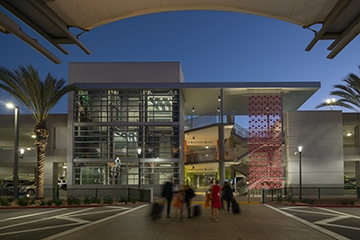Original Source: "Mineta San Jose International Airport Terminal Area Improvement Program" by Greg Aragon, Fentress Architects, for ENR California, December 1, 2010

San Jose International Airport, which had a grand opening in June, has been called the country’s most technologically advanced airport and it’s easy to see why. The newly designed facility has a list of project components, amenities and innovations as long as a runway.
The primary piece of the airport’s $1.3-billion upgrade is the $750-million San Jose International Airport Area Improvement Program. This design-build project includes a new Terminal B, renovation and expansion of Terminal A, a new 3,000-space consolidated rental car facility, surface parking and roadway improvements.
The new 163,000-sq-ft Terminal B and concourse provides 12 gates and can serve up to 8.5 million passengers a year, over half of the airport’s 14.4 million annual capacity.
Notable project innovations include the nation’s first personal air-conditioned seating, advanced bag screening system, state-of-the-art earthquake safety, and being on track to become the first LEED silver passenger terminal in California.
The green Terminal A has been self-certified, and the new rental car garage follows best practices. Sustainable design strategies on Terminal A include a 1.1-megawatt solar array, which will produce at least 20% of the parking garage’s power. At 3.4 acres, the 4,680-panel array is one of the largest airport solar electric installations in the nation.
Another cool feature is the nation’s first Air Chair, which diffuses fresh air to individual travelers from the base of each seat. The seats are also wired with personal power outlets for convenient charging of laptops and mobile electronics. This innovation, developed by SJC airport officials, Zoeftig and Fentress Architects, comprises 25% of the seating, or 1,200 chairs in Terminal B.
And in keeping with increased security issues, Terminals A and B debuted the most technologically advanced automated in-line baggage screening system in the world. Using four CTX 9800s as its foundation, each terminal can scan up to 1,800 bags an hour. The eight new, fully-automated scanners can process as much luggage as the previous 24 machines.
The revolutionary technology scans the bags while they are moving, so they don’t have to stop, as required by prior scanners.
The airport project, covering more than 2.6 million sq ft, was undertaken to attract passengers lost to other, more modern Bay Area airports. It was built by a collaboration of the city of San Jose, Fentress Architects and Hensel Phelps Construction Co. In order to improve communication, the project team was located in the same building along with key subconsultants and subcontractors.
The city selected design-build to address three major challenges: to ensure seamless coordination between the airports multiple TAIP projects working within close proximity to each other; to mitigate any potential coordination gaps between the architect and contractor; and to accelerate the construction schedule from concept to completion.
Design-build also saved money.
“Just before we hired Fentress Architects and Hensel Phelps, we were $150 million over budget,” says Bill Sherry, director of aviation at SJC. “Now were more than $140 million under budget and celebrating the opening of the modernization one year earlier than if we’d done it as design-bid-build.”
Project Team
Developer/Owner:Mineta San Jose International Airport
Design-Build General Contractor:Hensel Phelps Construction Co., San Jose
Master Plan Architects: Fentress Architects, San Jose; Gensler, San Francisco; and Steinberg Architects, San Jose
Design Architect and Architect of Record for Terminals A, B and C: Fentress Architects, San Jose;
Civil Engineer: AECOM (formerly DMJM Harris), Orange
Structural Engineer:Magnusson Klemencic Associates, Seattle (for Terminal B); Martin/Martin, Lakewood, Colo. (for Terminals A and C)
MEP Engineer: AECOM (formerly DMJM Harris), Orange
Mechanical Engineer:Critchfield Mechanical, San Jose
Electrical Engineer: Rosendin Electric, San Jose
ConRAC: Fentress Architects, San Jose (façade architect); TranSystems, Kansas City (architect of record); Watry Design Inc., Redwood City (structural engineer)






